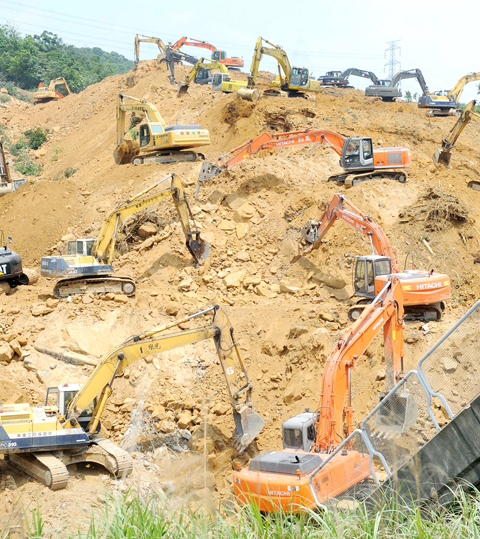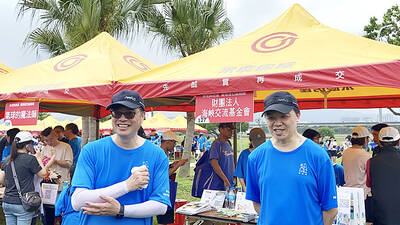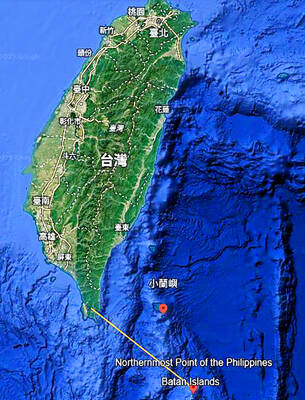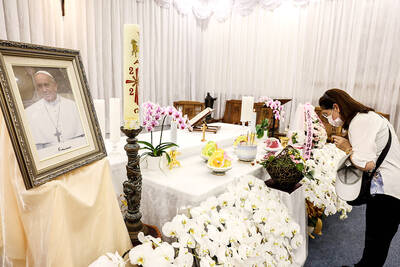About 1,000 workers were mobilized yesterday to remove the piles of earth and rock blocking the Formosa Freeway (Freeway No. 3) following a huge landslide on Sunday, the National Freeway Bureau said yesterday.
National Freeway Bureau chief engineer Lien Shyi-ching (盓鉊昑) said that the bureau was using 59 excavators and 140 gravel trucks for the cleanup.
Lien added that as of 2pm yesterday, the workers had removed 14,174m昆 out of the estimated 200,000m昆 that needs to be removed.

PHOTO: WANG MIN-WEI, TAIPEI TIMES
※Our goal is to increase the number of sites so that more machines and workers can get in. That way, we can work faster,§ Lien said, adding that the bureau is aiming to make the road accessible within two weeks.
Earlier yesterday, the Keelung City Fire Bureau said it had received nine calls from people concerned about missing relatives. It had contacted the owners of seven vehicles suspected of being buried in the landslide, but there are still two cars missing, the bureau said.
Reports of a third car have yet to be confirmed.
As of press time, no people or vehicles had been discovered by the digging crews.
As the landslide occurred on a dip slope, Lien said the bureau had started inspecting all dip slopes along freeways yesterday.
He said they all look fine at the moment, adding that they will invite construction experts and researchers to do a more thorough inspection.
The inspections could also determine the exact reason for the landslide, Lien said.
Lien said that yesterday he did not have the exact numbers of dip slopes along the nation*s freeways, whereas Minister of Transportation and Communications Mao Chi-kuo (椈鶵玿) said in a television interview yesterday that there were 〝approximately 20 in total.
Lien said the freeway was constructed by the National Expressway Engineering Bureau, and the National Freeway Bureau was in charge of maintaining it. Aside from daily inspections, where engineers determine whether there are any visually observable changes on the slopes, Lien said that the National Freeway Bureau also conducts a more detailed inspection every one to two months.
The inspection requires engineers to climb the slopes and observe any changes, he said.
The bureau said the last detailed inspection of the slope that collapsed was on Feb. 1.
Results of that inspection indicated that the ground anchors intended to hold the land were intact, and the diversion ditches were not deformed. Lien said the ground anchors on the slope were not damaged at all after the landslide, adding that the land that slid onto the freeway came from the part of slope that was not anchored during the construction process.
The landslide has caused great disruption to those commuting between Keelung and Taipei after the National Freeway Bureau decided on Sunday night to close both the northbound and southbound lanes north of the Sijhih (鈺糬) Interchange of Freeway No. 3. Traffic congestion was reported yesterday during rush hour between Keelung and Taipei on the Sun Yat-Sen Freeway (Freeway No.1). Between 6am and 9am, the traffic volume increased by 40 percent compared with that on a regular day, the Freeway Bureau said.
The bureau has suggested motorists consider taking alterative routes. Maps of alternative routes are available for download from the bureau*s home page at www.freeway.gov.tw.
To ease the traffic on the Freeway No.1, the National Freeway Bureau decided yesterday that it will open the road shoulders for traffic on the southbound lanes between Sijhih (鈺糬) and Donghu (娵?) from 7am to 7pm daily, starting today.
The Ministry of Transportation and Communications has asked the Taiwan Railway Administration and freeway bus operators to increase services to help transport more passengers.
The 430.5km No. 3 National Freeway was the second North-South freeway built in Taiwan. It begins on Provincial Highway No. 2 near Keelung City and ends on Provincial Highway No. 17 in Pingtung County.
Construction began in 1987 and the first completed section was opened for traffic in 1993. The section affected by the landslide opened in 2000.
ADDITIONAL REPORTING BY CNA

SECURITY: As China is ‘reshaping’ Hong Kong’s population, Taiwan must raise the eligibility threshold for applications from Hong Kongers, Chiu Chui-cheng said When Hong Kong and Macau citizens apply for residency in Taiwan, it would be under a new category that includes a “national security observation period,” Mainland Affairs Council (MAC) Minister Chiu Chui-cheng (邱垂正) said yesterday. President William Lai (賴清德) on March 13 announced 17 strategies to counter China’s aggression toward Taiwan, including incorporating national security considerations into the review process for residency applications from Hong Kong and Macau citizens. The situation in Hong Kong is constantly changing, Chiu said to media yesterday on the sidelines of the Taipei Technology Run hosted by the Taipei Neihu Technology Park Development Association. With

CARROT AND STICK: While unrelenting in its military threats, China attracted nearly 40,000 Taiwanese to over 400 business events last year Nearly 40,000 Taiwanese last year joined industry events in China, such as conferences and trade fairs, supported by the Chinese government, a study showed yesterday, as Beijing ramps up a charm offensive toward Taipei alongside military pressure. China has long taken a carrot-and-stick approach to Taiwan, threatening it with the prospect of military action while reaching out to those it believes are amenable to Beijing’s point of view. Taiwanese security officials are wary of what they see as Beijing’s influence campaigns to sway public opinion after Taipei and Beijing gradually resumed travel links halted by the COVID-19 pandemic, but the scale of

A US Marine Corps regiment equipped with Naval Strike Missiles (NSM) is set to participate in the upcoming Balikatan 25 exercise in the Luzon Strait, marking the system’s first-ever deployment in the Philippines. US and Philippine officials have separately confirmed that the Navy Marine Expeditionary Ship Interdiction System (NMESIS) — the mobile launch platform for the Naval Strike Missile — would take part in the joint exercise. The missiles are being deployed to “a strategic first island chain chokepoint” in the waters between Taiwan proper and the Philippines, US-based Naval News reported. “The Luzon Strait and Bashi Channel represent a critical access

Pope Francis is be laid to rest on Saturday after lying in state for three days in St Peter’s Basilica, where the faithful are expected to flock to pay their respects to history’s first Latin American pontiff. The cardinals met yesterday in the Vatican’s synod hall to chart the next steps before a conclave begins to choose Francis’ successor, as condolences poured in from around the world. According to current norms, the conclave must begin between May 5 and 10. The cardinals set the funeral for Saturday at 10am in St Peter’s Square, to be celebrated by the dean of the College